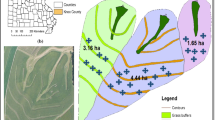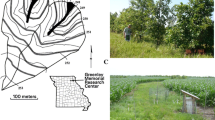Abstract
Agroforestry buffers have recently been introduced in temperate regions to enhance conservation of soil and water resources in row crop management. The effects of agroforestry and grass-legume buffers on in situ water infiltration relative to row crop management (RC) were assessed for a claypan soil in northeastern Missouri, USA. Infiltration rates were observed in early June in 2014 and 2015 for watersheds under corn (Zea mays L.)-soybean (Glycine max L. Merr.) management; these watersheds had agroforestry buffers (AGB) or grass buffers (GB). The dominant soil for the watersheds was Putnam silt loam (fine, smectitic, mesic Vertic Albaqualf). The watersheds were in no-till management and established in 1991 with agroforestry buffers and GBs implemented in 1997. Agroforestry buffers, 4.5 m wide and 36.5 m apart, consisted of redtop (Agrostis gigantean Roth), brome (Bromus spp.), and birdsfoot trefoil (Lotus corniculatus L.) with pin oak (Quercus palustris Menchh.), swamp white oak (Q. bicolor Willd.), and bur oak (Q. macrocarpa Michx.) trees. GBs consisted of redtop, brome, and birdsfoot trefoil. Significant differences were found among the treatments in 2014 for the sorptivity parameter for the fitted infiltration equations with the highest values for agroforestry buffers. Significantly higher saturated hydraulic conductivity values were found for the buffer treatments in 2015. Soil water content measurements were assessed over time for years 2010 and 2011 with sensors at 5, 10, 20 and 40 cm depths for the agroforestry buffer and RC areas. Water content decreased more rapidly during the summer season within agroforestry buffers relative to RC areas; however, water infiltration was higher within agroforestry buffers during the recharge period.














Similar content being viewed by others
References
Anderson SH, Udawatta RP, Seobi T, Garrett HE (2009) Soil water content and infiltration in agroforestry buffer strips. Agrofor Syst 75(1):5–16
Bradford JM, Ferris JE, Remley PA (1987) Interrill soil erosion processes: I. Effect of surface sealing on infiltration, runoff, and soil splash detachment. Soil Sci Soc Am J 51(6):1566–1571
Clothier B, Scotter D (2002) Unsaturated water transmission parameters obtained from infiltration. In: Dane JH, Topp GC (eds) Methods of soil analysis, part 4. SSSA, Madison, pp 879–898
Commercial Agriculture Program of University Extension (2015) Missouri historical agricultural weather database (online). http://agebb.missouri.edu/weather/history/index.asp?station%20prefix=nov
Gold MA, Hanover JW (1987) Agroforestry systems for temperate zone. Agrofor Syst 5(2):109–121
Green WH, Ampt GA (1911) Studies on soil physics: 1. Flow of air and water through soils. J Agric Sci 4(1):1–24
Hatfield JL (2015) Environmental impact of water use in agriculture. Agron J 107:1554–1556
Hopmans JW, Clausnitzer V, Kosugi KI, Nielsen DR, Somma F (1997) Vadose zone measurement and modeling. Sci Agric 54:22–26
Institute SAS (1999) SAS user’s guide. Statistics. SAS Institute, Cary
Jose S (2009) Agroforestry for ecosystem services and environmental benefits: an overview. Agrofor Syst 76(1):1–10
Jose S, Gillespie AR, Seifert JR, Biehle DJ (2000) Defining competition vectors in temperate alley cropping system in the Midwestern USA: 2. Competition for water. Agrofor Syst 48(1):41–59
Lovell ST, Sullivan WC (2006) Environmental benefits of conservation buffers in the United States: evidence, promise, and open questions. Agric Ecosyst Environ 112(4):249–260
Lowrance R, Dabney S, Schultz R (2002) Improving water and soil quality with conservation buffers. J Soil Water Conserv 57(2):37A–43A
Or D, Wraith JM (2002) Soil water content and water potential relationships. In: Warrick AW (ed) Soil physics companion. CRC Press, Boca Raton, pp 49–84
Parlange JY, Lisle I, Braddock RD, Smith RE (1982) The three-parameter infiltration equation. Soil Sci 133(6):337–341
Philip JR (1957) The theory of infiltration: 4. Sorptivity and algebraic infiltration equation. Soil Sci 84(3):257–264
Rachman A, Anderson SH, Gantzer CJ, Alberts EE (2004) Soil hydraulic properties influenced by stiff-stemmed grass hedge systems. Soil Sci Soc Am J 68(4):1386–1393
Radke JK, Berry EC (1993) Infiltration as a tool for detecting soil changes due to cropping, tillage and grazing livestock. Am J Altern Agric 8(04):164–174
Reynolds WD, Elrick DE, Youngs EG, Amoozegar A (2002) Field methods (vadose and saturated zone techniques). In: Dick WA (ed) Methods of soil analysis. Part 4. SSSA, Madison, pp 817–826
Seobi T, Anderson SH, Udawatta RP, Gantzer CJ (2005) Influence of grass and agroforestry buffer strips on soil hydraulic properties for an Albaqualf. Soil Sci Soc Am J 69(3):893–901
Stone KC, Hunt PG, Novak JM, Johnson MH, Watts DW, Humenik FJ (2004) Stream nitrogen changes in an eastern coastal plain watershed. J Soil Water Conserv 59(2):66–72
Topp GC, Ferré PA (2002) The soil solution phase. In: Dick WA (ed) Methods of soil analysis. Part 4. SSSA, Madison, pp 417–573
Udawatta RP, Krstansky JJ, Henderson GS, Garrett HE (2002) Agroforestry practices, runoff. And nutrient loss: a paired watershed comparison. J Environ Qual 31(4):1214–1225
Udawatta RP, Nygren P, Garrett HE (2005) Growth of three oak species during establishment of an agroforestry practice for watershed protection. Can J For Res 35(3):602–609
Udawatta RP, Gantzer CJ, Anderson SH, Garrett HE (2008) Agroforestry and grass buffer effects on pore characteristics measured by high-resolution X-ray computed tomography. Soil Sci Soc Am J 72(2):295–304
Udawatta RP, Anderson SH, Motavalli PP, Garrett HE (2011) Calibration of a water content reflectometer and soil water dynamics for an agroforestry practice. Agrofor Syst 82(1):61–75
Walker WJ, Branham B (1992) Environmental impacts of turfgrass fertilization. In: Balogh JC, Walker WJ (eds) Golf course management and construction: environmental issues. Lewis Publ, Chelsea, pp 105–219
Author information
Authors and Affiliations
Corresponding author
Rights and permissions
About this article
Cite this article
Sahin, H., Anderson, S.H. & Udawatta, R.P. Water infiltration and soil water content in claypan soils influenced by agroforestry and grass buffers compared to row crop management. Agroforest Syst 90, 839–860 (2016). https://doi.org/10.1007/s10457-016-9899-x
Received:
Accepted:
Published:
Issue Date:
DOI: https://doi.org/10.1007/s10457-016-9899-x




